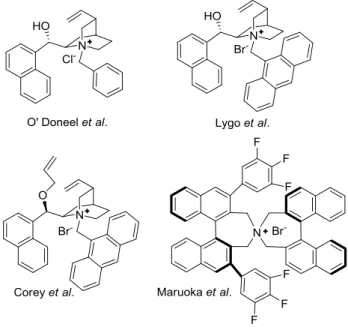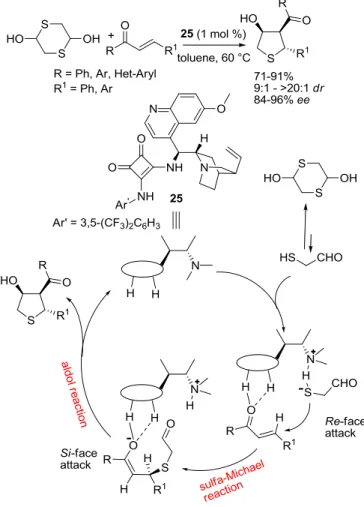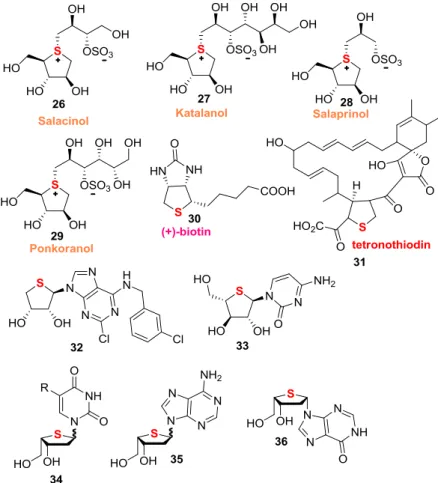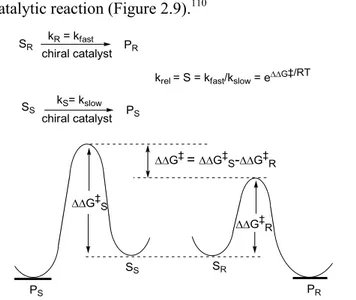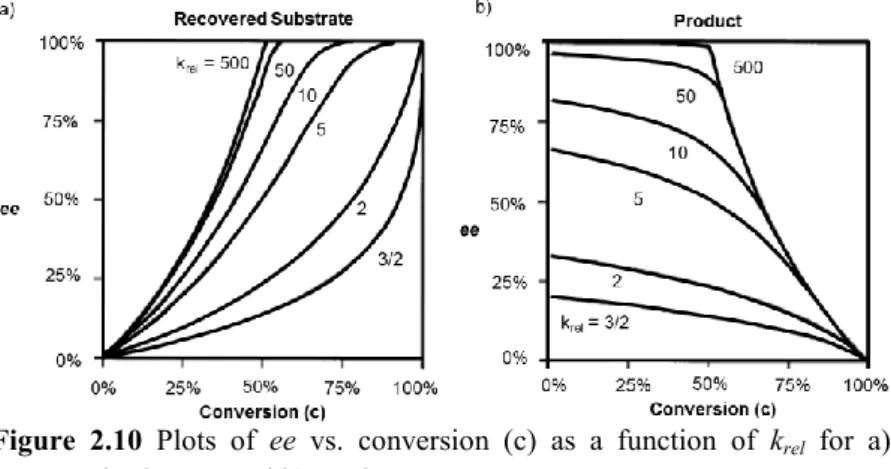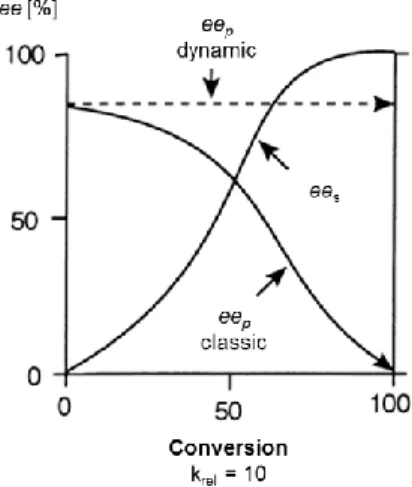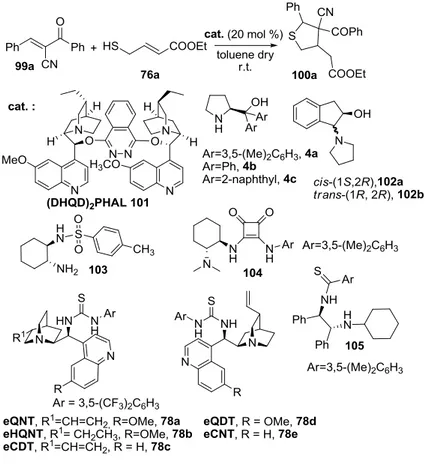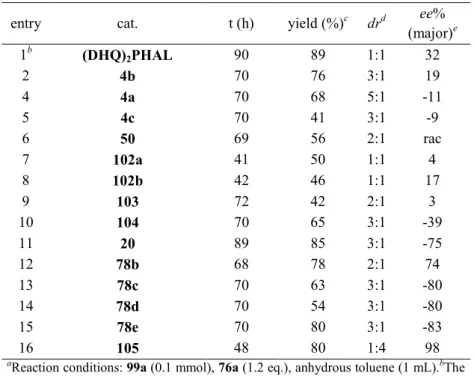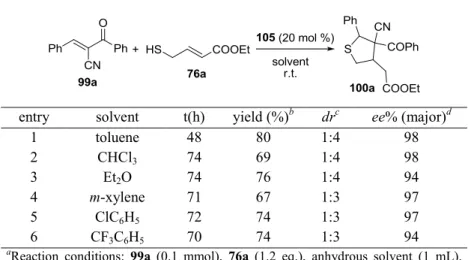UNIVERSITY OF SALERNO
DEPARTMENT OF CHEMISTRY AND BIOLOGY Ph. D. Course in “Chemistry” - XIII Cycle
Ph. D. Thesis in Chemistry
CHIRAL ORGANOCATALYSTS MEDIATED
ASYMMETRIC OXYFUNCTIONALIZATION
AND TANDEM REACTIONS
Tutor:
Prof. A. Lattanzi
Co-tutors: Prof. R. Zanasi
Dr. L. Arista (Novartis, Basel, Switzerland) PhD Coordinator Prof. G. Guerra Doctorate Student: Sara Meninno 2012 - 2015
“Credo di poter affermare che nella ricerca scientifica né il grado di intelligenza né la capacità di eseguire e portare a termine il compito intrapreso siano fattori essenziali per la riuscita e per la soddisfazione personale. Nell'uno e nell'altro contano maggiormente la totale dedizione e il chiudere gli occhi davanti alle difficoltà: in tal modo possiamo affrontare i problemi che altri, più critici e più acuti, non affronterebbero”.
Index
ABSTRACT ... iv
LIST OF ABBREVIATIONS ... viii
1. INTRODUCTION: ASYMMETRIC ORGANOCATALYSIS ... 1
1.1 Asymmetric Synthesis ... 1
1.2 Historical Background ... 6
1.3 Mechanistic Aspects ... 11
1.3.1 Lewis base catalysis ... 11
1.3.2 Lewis acid catalysis ... 15
1.3.3 Brønsted acid catalysis ... 21
1.3.4 Brønsted base catalysis ... 26
1.4 Bifunctional Organocatalysts ... 29
2. ASYMMETRIC SYNTHESIS OF TETRAHYDROTHIOPHENES BEARING A QUATERNARY STEREOCENTRE ... 39
2.1 Tandem Reactions ... 39
2.1.1 Domino catalysis ... 40
2.1.2 Tandem catalysis ... 44
2.2 Background ... 50
2.2.1 Enantioselective organocatalytic sulfa-Michael additions 55 2.2.1.2 Organocatalytic cascade Michael/aldol and Michael/Michael processes for asymmetric synthesis of tetrahydrothiophenes ... 65
2.3 Kinetic Resolution and Dynamic Kinetic Resolution ... 75
2.4 Results and Discussion ... 86
CONCLUSIONS ... 101
3. ENANTIOSELECTIVE SYNTHESIS OF γ-BUTYROLACTONES BEARING AN ALL-CARBON β-QUATERNARY STEREOCENTRE ... 102
3.1 Background ... 102
3.2 Results and Discussion ... 122
CONCLUSIONS ... 139
4. ORGANOCATALYTIC ENANTIOSELECTIVE SYNTHESIS OF α-NITROEPOXIDES VIA KINETIC RESOLUTION ... 140
4.1 Background ... 140
4.1.1 Epoxidation of nitroalkenes ... 143
4.1.2 Ring-opening of α-nitroepoxides ... 145
4.2 Results and Discussion ... 156
CONCLUSIONS ... 166
5. ENANTIOSELECTIVE α- HYDROXYLATION OF β-KETOAMIDES ... 167
5.1 Background ... 167
5.1.1 α-Hydroxylation of aldehydes and ketones ... 169
5.1.2 α-Hydroxylation of 1,3-dicarbonyl compounds ... 170
5.1.2.1 α-Hydroxylation of β-ketoamides ... 181
5.2 Results and Discussion ... 184
CONCLUSIONS ... 195
SUMMARY ... 196
6. EXPERIMENTAL SECTION ... 199
6.1 General experimental conditions ... 199
6.2 Asymmetric synthesis of tetrahydrothiophenes bearing a quaternary stereocentre ... 201
6.3 Enantioselective synthesis of γ-butyrolactones bearing an all-carbon β-quaternary stereocentre ... 230
6.4 Organocatalytic enantioselective synthesis of α-nitroepoxides via kinetic resolution ... 276
6.5 Enantioselective α-hydroxylation of β-ketoamides ... 293
Acknowledgments
I would like to thank Professor Alessandra Lattanzi, my exceptional supervisor, for her guidance, patience, her many precious suggestions and constant encouragement during my Ph.D. She was for me a real guide, a constant and precious point of reference.
Thank you so much for the wonderful research experience, for giving me the opportunity to grow scientifically.
I am grateful to the wonderful people with whom I shared part of my research: Dr. Claudia De Fusco, Tiziana Fuoco, Loris Napolitano, Andreu Vidal-Albalat. They have been source of fun and inspiration. It was a great pleasure working with you!
Of course I also want to thank my friends of lab. 37 and my colleagues of department of chemistry. I was lucky to be surrounded by kind, friendly and always helpful people.
I would like to thank my parents, and there would be too many things to say. They taught me to always pursue my ambitions and they have always encouraged me.
Last, but not least, very special thanks go to Ciro for always standing by me.
Thanks to Dr G. Croce (University of Piemonte Orientale) and Dr. C. Tedesco (University of Salerno) for X-ray analysis, Dr. P. Iannece (University of Salerno) and Prof. C. Crescenzi (University of Salerno) for assistance with MS spectra and elemental analyses, Dr. P. Oliva (University of Salerno) with NMR spectroscopy and the European COST Action CM0905-Organocatalysis.
ABSTRACT
Asymmetric organocatalysis is a new rapidly growing field whose huge potential is becoming more and more evident. This PhD project has been conceived and developed in the context of non-covalent organocatalysis.
The aim of this work has been to design, plan and develop new organocatalytic methodologies for the synthesis of optically active, densely functionalized, organic molecules whose functional groups are susceptible to further manipulation. The target molecules represent important motifs present in many biologically active natural and non-natural substances.
The catalysts used are small chiral organic molecules, in particular the attention has been focused on bifunctional organocatalysts. The main features of the catalysts are their non-toxicity, stability to air and moisture and the ability to work under mild conditions that make them convenient tools in organic chemistry. These promoters are able to synergistically activate both the electrophile and the nucleophile through multiple hydrogen-bonding interactions provided by their acid and basic groups with the reactive groups of the reagents. The best-performing chiral scaffold of the bifunctional organocatalysts, employed in the methodologies herein developed, has been selected screening the activity of previously reported promoters such as ureas, thioureas, squaramides, amino alcohols. However, the design and synthesis of new optically pure bifunctional organocatalysts, modifying the
stereoselective construction of a quaternary stereocentre, especially when it is an all-carbon quaternary stereocentre, is one of the most difficult goals in organic synthesis due to the steric congestion imposed by the four attached substituents. In this project, the synthesis of challenging molecules, bearing quaternary stereocentres in their structure, has been accomplished.
The methodologies developed aimed to the stereocontrolled construction of carbon-carbon and carbon-heteroatom bonds to give access to new and important cyclic compounds of different nature and size (such as epoxides, tetrahydrothiophenes, γ-butyrolactones) and non-cyclic compounds, such as α-hydroxy β-ketoamides. In order to access the cyclic compounds, the one-pot tandem organocatalytic methodologies developed, such as Michael/Michael, aldol/lactonization, allowed us to obtain the densely functionalized molecules with a minimum number of synthetic operations. Unquestionably, these processes are becoming of considerable synthetic interest in terms of sustainability and advantageous in terms of time, costs saving issues and minimal manual operations.
In this doctoral work, the first stereoselective cascade sulfa-Michael/Michael reaction for the synthesis of tetrahydrothiophenes from trans-α-carbonyl-β-substituted acrylonitriles has been developed, by using a novel readily available secondary amine thiourea. Highly functionalized tetrahydrothiophenes, bearing three contiguous stereocentres, one of them quaternary, were formed by means of a highly stereoselective cascade transformation. This work represents an unprecedented case in which the stereochemical
outcome of an asymmetric synthesis of tetrahydrothiophenes has been controlled exclusively by a dinamic kinetic resolution process. The first straighforward approach to enantioenriched β,β-disubstituted γ-butyrolactones has been achieved through a cascade aldol/lactonization process. From simple starting materials and working under mild reaction conditions, highly challenging γ-butyrolactones, bearing an all-carbon quaternary stereocentre at the remote β-position were obtained. Remarkably, this work represents the first example of an enantioselective hydroxymethylation reaction of 2-substituted-1,3-dicarbonyl compounds catalyzed by an organocatalyst.
Moreover, we demonstrated that these products can be elaborated to prepare valuable hydroxy γ-butyrolactones, bearing contiguous tertiary and quaternary stereocentres, so far inaccessible via alternative methods.
Another important goal of this project concerned the development of a first approach to enantiomerically enriched aromatic α-nitroepoxides. An aminolytic kinetic resolution of racemic aromatic α-nitroepoxides with aniline, catalyzed by an easily accessible cinchona alkaloid-derived thiourea, was devised as a successful strategy. The first demonstration of synthetic utility of the chiral epoxides obtained has been reported: they have been transformed into highly valuable anti-1,2-amino alcohols through an one-pot stereoselective ring-opening reaction followed by reduction.
α-available HQN/TBHP system, has been realized in this PhD project. This protocol enables a facile access to functionalized tertiary alcohols bearing a quaternary stereocentre, substituted with both ketone and amido groups, amenable to chemoselective manipulation.
LIST OF ABBREVIATIONS
Ad adamantyl
Ac acetyl
ACDC Asymmetric Counteranion-Directed Catalysis AcOH Acetic acid
AKR aminolytic kinetic resolution
Alk alkyl aq. aqueous Ar aryl BINAP 2,2′-Bis(diphenylphosphino)-1,1′-binaphthyl BINOL 1,1’‐bi‐2-naphthol Bn benzyl Boc tert-butyloxycarbonyl br broad Bu butyl cat. catalyst(s) Cbz carbobenzyloxy CHP cumene hydroperoxide CD cinchonidine CN cinchonine C Concentration c cyclic d days d doublet DABCO 1,4-Diazabicyclo[2.2.2]octane dba dibenzylideneacetone dd double doublet
DCM dichloromethane
de diastereoisomeric excess DHQD dihydroquinidine diast. diastereomer
DIBAL-H diisobutylaluminum hydride DIC diisopropylcarbodiimide DMAP 4-(Dimethylamino)pyridine DME 1,2-dimethoxyethane DMF dimethylformamide DMSO dimethylsulfoxide dr diastereoisomeric ratio DSIs disulfonimides ee enantiomeric excess El electrophile eq. equivalent(s)
eCDT 9-Amino-(9-deoxy)epi-cinchonidine thiourea eCNT 9-Amino-(9-deoxy)epi-cinchonine thiourea eHQNT 9-Amino-(9-deoxy)epi-hydroquinine thiourea eQDT 9-Amino-(9-deoxy)epi-quinidine thiourea eQNT 9-Amino-(9-deoxy)epi-quinine thiourea er enantiomeric ratio
ESI electrospray ionization
Et ethyl
G Gibbs energy
h hour(s)
Het heteroaromatic
hex hexyl
HOMO Higher Occupied Molecular Orbital HPLC high performance liquid chromatography
Hz Herz
i iso
IUPAC International Union of Pure and Applied Chemistry KHMDS hexamethyldisilazane potassium salt
LDA lithium diisopropylamide LUMO Lower Unoccupied Molecular Orbital M molar (concentration)
m meta
m multiplet
mCPBA meta-chloroperbenzoic acid
Me Methyl
min minutes
mp melting point
MS mass spectrometry
MS molecular sieves
MTBE methyl tert-butyl ether m/z atomic mass units per charge
Nap naphthyl
nd not determined
NMP N-methyl-2-pyrrolidone
NMR nuclear magnetic resonance spectroscopy
Nu nucleophile o ortho p para P protecting group PCC pyridinium chlorochromate Ph phenyl PMB p-methoxybenzyl
Pr propyl
PTC Phase Transfer Catalysis PTSA p-toluenesulfonic acid
q quartet QN quinine QD quinidine r.t. room temperature s singlet s sec SN nucleophilic substitution t tert t time t triplet T Temperature TADDOL α,α,α’,α’‐tetraaryl‐1,3‐dioxolan‐4,5‐dimethanol TBDMS tert-butyldimethylsilyl TBDPS tert-butyldiphenylsilyl TBHP tert-butyl hydroperoxide TBME tert-butylmethyl ether
Tf triflate
TFA trifluoroacetic acid TFAA trifluoroacetic anhydride THF tetrahydrofuran TIPS triisopropylsilyl TMS tetramethylsilyl Tol. toluene tol p-tolyl TPP tetraphenylporphyrin tR retention time
TS transition state TSA p-toluenesulfonic acid TSOH p-toluenesulfonic acid UHP urea hydrogen peroxide
1. INTRODUCTION: ASYMMETRIC
ORGANOCATALYSIS
1.1 Asymmetric Synthesis
IUPAC defines Asymmetric Synthesis as: “a chemical reaction (or reaction sequence) in which one or more new elements of chirality are formed in a substrate molecule and which produces the stereoisomeric (enantiomeric or diastereoisomeric) products in unequal amounts”.1
More enantiopure is a compound, more is “valuable”. In fact, it should be kept in mind that life is strictly connected with chirality. Many building blocks of the biological systems are chiral, such as sugars and amino acids, and the chirality is often the basis of the interactions receptor-substrate. Frequently, only one enantiomer is recognized by its receptor and the opposite is inactive, less active or, in some cases, it is even a poison. This concept is very important in the field of pharmaceutical industry. For example, an α-amino acid metabolite of penicillin, the D-penicillamine, sold under the trade names Cupreimine and Depen, is active in treatment of rheumatoid arthritis and used as chelating agent in the treatment of several diseases such as the Wilson’s desease. The enantiomer L-penicillamine, on the contrary, is toxic because inhibits the action of the B vitamin pyridoxine.
The opposite chirality of the enantiomers leads, in hundreds of known compounds, also to differences in flavor and in the aroma.2
Figure 1.1: the (R)-limonene has a strong smell of oranges while the (S)-isomer of turpentine.
Figure 1.1 (R)- and (S)-limonene.
Other classical examples of enantiomers showing different odour and/or taste properties are amino-acids - L-amino acids usually are bitter while D-amino acids are sweet - carvone, menthol, β-cintronellol and linalool.
The enantioselective synthesis is difficult to achieve because enantiomers have identical enthalpies and entropies. In achiral reactions they are produced in equal amounts, as racemic mixture, because transition states that lead to enantiomers are also enantiomeric, having equal energy. The only way to perform a reaction in a stereoselective manner is to use a chiral “component” that produces diastereomeric transition states with different energy leading the formation of one enantiomer over another (Figure 1.2).3
Figure 1.2 Gibbs free energy plots of (a) an achiral and (b) a chiral
reaction.
An approach to asymmetric synthesis involves the use of molecules from the chiral pool: chiral non racemic starting materials are manipulated through successive reactions, often using achiral reagents, to obtain the desired enantiopure molecule. However, this approach is not cheap because a stoichiometric amount of a chiral reagent is required, the synthetic routs may be not very easy and, unfortunately, the range of enantiopure compounds provided by Nature is limited with respect to structure and stereochemistry. It is possible to use chiral auxiliaries, chiral solvents or chiral catalysts in order to make the activation energy needed to form an enantiomer lower than needed for the opposite enantiomer.
In a reaction that occurs in solution, components are solvated, therefore, if the solvent is chiral, it is possible to have an asymmetric synthesis because transition states become diastereomeric. Nevertheless, chiral solvents are seldom utilized because the level of stereoselectivity is often low and not predictable and a large amount of chiral substance is required. Chiral auxiliaries, hooked to the prochiral substrate before the reaction, are used in stoichiometric amounts and this strategy
requires additional synthetic steps to append and remove the auxiliary. However, the reactions usually give predictable and reproducible results, the auxiliary can be recycled and purification is usually easy because the products are diastereomeric. In some cases, this is the only available stereoselective methodology to access enantiomerically pure products.
An alternative approach to perform an asymmetric synthesis is the kinetic resolution: in the presence of an enantiomerically pure reagent or a catalyst, the two enantiomers of a racemate can have different reaction rates. If the rate difference is very large (the ideal cases are enzymes) one enantiomer is inert and the other one reacts quickly and the product can be separated from the unreacted enantiomer.
The asymmetric synthesis performed employing chiral catalysts provides the best “atom economy”, because the amount of chiral substance used in the transformation is minimized.
Until recently, the catalytic enantioselective synthesis of chiral organic compounds such as agrochemicals, synthetic intermediates and pharmaceuticals was based on metal and enzymatic catalysis.4
The organometallic catalysis is the field that received more emphasis in asymmetric synthesis over the years. The chiral organometallic catalysts can be modulated and tailored to many kinds of organic reactions. Several transformations in asymmetric catalysis are promoted by organometallic complexes and there are many well-established metal-based methodologies in this field.5 At
useful enzymes from novel organisms and optimize the enzyme performance by evolutionary methods and selective mutation.6
Nevertheless, in the last ten years, this picture is changing: between these two pillars the organocatalysis has emerged.7 As
metal complexes and enzymes, even small organic molecules may promote chemical reactions. Organic molecules, without metal element, used in a substoichiometric amount, are useful means to accelerate chemical transformations.
Organocatalysis offers several advantages over transition metal- and bio-catalysis: reactions can be performed under an aerobic atmosphere, with not perfectly anhydrous solvents, indeed, in some cases, the presence of water has proven to be beneficial to the rate and selectivity of the reaction. Organocatalysts are usually readily available, less toxic and cheaper than metal complexes. They are more stable and robust than metal complexes and enzymes. The risk of metal leakage is avoided and no expensive waste treatment is required. Thanks to the sustainability of the catalysts, environmentally friendliness and green features, organocatalysis has found applications in several industrial asymmetric syntheses.8
Moreover, these organic catalysts are particularly efficient in promoting tandem stereoselective multistep and multicomponent reactions, thus offering the opportunity to increase the structural complexity of the products.
1.2 Historical Background
The organocatalysis has a very ancient story: there are evidences that such catalysis has played a key role in the beginning of life on Earth. It is thought that such catalysis has been responsible for the formation of probiotic key building-blocks such as sugars, leading to the birth of homochirality in living systems.9 Pizzarello and Weber demonstrated that L-isovaline, found in the Murchison meteorite, promotes the self- aldol reaction of glycolaldehyde in water, generating sugar aldol products such as L-threose and D-erythrose with up to 10.7 ± 1.2% and 4.8 ± 0.9% ee, respectively.9 This means that enantiomerically enriched amino acids such as L-alanine and L-isovaline, which may be present in up to 15% ee in carbonaceous meteorites, probably were able to catalyze aldol reactions of glycolaldehyde and formaldehyde producing sugar derivatives. After the formation of sugars, more complex carbohydrates and complex molecules such as DNA and RNA were formed. Most likely, prebiotic RNA had a key role in basic biochemical transformations necessary for life, in which sugars were the chiral templates.10 For example, it is believed, that, as the
first step of protein synthesis is the asymmetric aminoacylation, the homochirality of RNA determined homochirality of amino acids in proteins and hence the selectivity of the amino acids (L or D) derived.11
Scheme 1.1 von Liebig’s oxamide synthesis.
Later, this reaction has been the basis of the industrial Degussa oxamide synthesis.
The organocatalysis was born when chemists began to use little organic molecules in an attempt to understand and to mimic the catalytic activity and selectivity displayed by enzymes.
In 1912, Bredig and Friske discovered that quinine and quinidine accelerate the addition of HCN to benzaldehyde giving chiral cyanohydrins of opposite chirality, albeit with low ee (≤ 10%).12
Subsequently, Pracejus et al., in 1960, obtained the product of addition of methanol to phenylmethylketene in 74% ee using 1 mol % O-acetylquinine as the catalyst (Scheme 1.2).13
Scheme 1.2 Pracejus’ reaction.
Further milestones in the organocatalysis field were laid in the 1970s and 1980s. In 1971, Hajos-Parrish-Eder-Sauer-Wiechert reported the synthesis of an important intermediate in steroid synthesis, the Wieland-Miescher ketone, exploiting a
proline-catalyzed enantioselective intramolecular aldol reaction (Scheme 1.3).14
Scheme 1.3 The L-proline catalyzed Robinson annulation.
The real growth of organocatalysis has taken place, however, in the early 2000s when List, Barbas et al. disclosed that acetone can react with a number of aldehydes in the presence of L-proline, obtaining the corresponding aldols in high yield and excellent enantiomeric excess. For example, with iso-butyraldehyde the product was isolated in 97% yield and 96% ee (Scheme 1.4).15
Scheme 1.4 Intermolecular aldol reaction catalyzed by L-proline.
List and Barbas’ pioneering work has given rise to an intense study by several research groups on the catalytic activity of L-proline in many organic reactions such as Michael, Mannich, aldol and so on. Another catalyst widely adopted in several reactions, after its discovery in the same year of List and Barbas’ work, was the phenylalanine-derived secondary amine 1 (Scheme 1.5). MacMillan demontrated that the Diels-Alder reaction of α,β-unsaturated
aldehydes is effectively catalyzed in terms of yield and enantioselective by compound 1 (Scheme 1.5).16
Scheme 1.5 Diels-Alder reaction promoted by MacMillan’s catalyst.
A massive research activity in the field of peptide-catalyzed reactions started after the Inoue’s work in 1981. The cyclic dipeptide 2 derived from L-histidine and L-phenylalanine catalyzes the reaction between HCN and benzaldehyde giving the product with 90% ee (Scheme 1.6).17
Scheme 1.6 The dipeptide catalyst by Inoue.
In the same period, Juliá, Colonna et al. reported the highly enantioselective epoxidation of chalcones with hydrogen peroxide promoted by catalyst 3 (Scheme 1.7).18
Scheme 1.7 Enantioselective Juliá-Colonna epoxidation.
In summary, although the first catalytic reactions date back to the early 1900s, organocatalysis had a very slow growth until the early 2000s, when an exponential growth of organocatalysis led off with the groundbreaking works of List, Barbas, MacMillan and others. Every year, new methodologies promoted by new organocatalysts are published and the studies are becoming more sophisticated, complex and in-depth thanks to the advancement of analytical techniques and the support of theoretical and computational chemistry.
1.3 Mechanistic Aspects
Generally, the organocatalytic reactions can be grouped into two categories depending on whether the structure of the transition state between catalyst and substrate/s is “tight” or “loose”. The former category is defined covalent catalysis and includes reactions in which covalent bonds between the catalyst and reagent/s are formed with energies higher than 15 kcal mol-1. The latter set involves
reactions in which complexes maintained by non-covalent bonds, between the catalyst and the substrate, are formed. These non-covalent interactions are weaker – ion pairing, neutral host-guest interactions, acid-base associations, H-bonding – with energies that usually don’t exceed 4 kcal mol-1.
The bonds formed in the transition state are determined by the activation strategy of the substrates by the catalyst and by its chemical nature. Most but not all organocatalysts can be grouped in four typologies: Lewis base, Lewis acid, Brønsted base or Brønsted acid.19
1.3.1 Lewis base catalysis
Unlike metal catalysts, which act as Lewis acids, organocatalysts form especially Lewis bases. The Lewis base can be centred on N-, C-, O-, P-, and S- but the N- and P-based catalysts are the most used and studied. The amine catalysts are more easily available than phosphorus ones and these latter catalysts have to be synthesized. Since the phosphorus atom is less basic than amine nitrogen, the phosphorus Lewis basic catalysts are chosen when it’s necessary to
avoid side reactions promoted by the base.
There are various activation mechanisms depending on the Lewis base and several are the intermediates that are formed. The intermediates are nucleophiles or electrophiles, more reactive than the starting reagents. Some of them are shown in Scheme 1.8.19
Scheme 1.8 Intermediates formed in Lewis base organocatalysis.
All the examples of Lewis base organocatalysis are examples of covalent catalysis and an important subcategory widely used is the so-called aminocatalysis.4,19,20
As we can see in the first two examples in the upper left in Scheme 1.8, the amine catalysts may activate the substrates forming
By the formation of the iminium ion the carbonyl carbon is made more electrophilic and the α-position more acidic (Scheme 1.9). This facilitates reactions such as Knoevenagel-type condensations, cleavage of σ-bonds adjacent to the α-carbon and cyclo- and nucleophilic additions. The formation of the enamine increases the electron density on the α-carbon, thus becoming more nucleophilic (Scheme 1.9).7 Enamines react with different electrophiles giving
aldol, Michael and Mannich reactions, α-functionalization of aldehydes and ketones or undergo pericyclic reactions. The enamine is generated by deprotonation of an ion iminium and the equilibrium between the two species (acid and basic form) is a protonation-deprotonation equilibrium which makes more active the reagents and also makes more kinetically labile the chiral catalyst.
Scheme 1.9
In the reaction mixture both species are formed and are in equilibrium with each other, so the same centre can behave both as a Lewis base and acid. The relative amount of the two species depends on the reaction conditions, therefore a chemical reaction can also have different mechanistic pathways giving different products. Morover, thanks to the fact that the same catalyst can
adopt both methods of activation, aminocatalysis is widely exploited in cascade reactions, especially with secondary amine catalysts.22
Primary amine organocatalysts have been less exploited than secondary amines and their use is more recent because the equilibrium between the iminium ion and enamine is unfavorable, almost completely shifted to the left toward the iminium ion. Recently, primary amines have been used to activate more congested substrates that did not react with secondary amines.23 α,α-Diarilprolinol ethers, such as 4a illustrated in Scheme 1.10 have been and are widely used in many α-functionalizations of carbonyl compounds and more recently in domino enantioselective reactions.24 For example, Jørgensen et al. reported a tandem
synthesis of tetrahydrothiophenes in which the catalyst 4a catalyzes first a thia-Michael addition via iminium catalysis, and then an intramolecular aldol cyclization, via enamine catalysis, in the same reaction pot (Scheme 1.10).25
Scheme 1.10 Tandem reaction catalyzed by prolinol catalyst.
1.3.2 Lewis acid catalysis
Lewis acid catalyst initiates the catalytic cycle activating the nucleophilic substrate accepting its electron pair. Brønsted acid catalysis is the major research field in acid organocatalysis.26 Until
today, the Lewis acid organocatalysis was the field less explored, as it has proven the most challenging.19,27
The phase transfer catalysts are an important class of organocatalysts and they can be considered as Lewis acids. The reactions promoted by PTCs fall into the non-covalent catalysis category because the interactions between catalyst and substrate/s are ion pairing-type. In these reactions, anionic intermediates are formed and their countercation, formed by the catalyst, is chiral. If the ion pairing association is sufficiently strong, chirality in the product is induced.
Figure 1.3 Phase-tranfer catalysis with chiral countercations (PTC).
S = substrate, X- = anion, NR
4+* = cationic chiral catalyst.
The first efficient phase transfer catalyst has been discovered by a group at Merk, who used it for the enantioselective α-methylation of indanone 5.28 It is a N-benzyl cinchonidinium salt 6 that
promoted the reaction giving the product in 95% yield and 92% ee (Scheme 1.11).
Figure 1.4 PTC catalysts.
Since then, the phase-transfer catalysis has made enormous progress and many other PTC catalysts have been developed.29 In
Figure1.4 are shown some examples.
In 2006, the concept of ACDC, asimmetric counteranion-directed catalysis was introduced (Figure 1.5).30 This type of catalysis is
conceptually the opposite of the phase-transfer catalysis. List defines it as: “the induction of enantioselectivity in a reaction proceeding through a cationic intermediate by means of ion pairing with a chiral, enantiomerically pure anion provided by the catalyst”.31
Figure 1.5 Asymmetric counteranion-directed catalysis (ACDC).
S = substrate, X- = anion.
The concept can be expanded to all types of enantioselective catalytic reactions whose mechanism involves cationic intermediates in the stereodetermining step.
In the mechanism of this type of catalysis ion pairs are involved. An ion pair was defined by Anslyn and Dougherty: “An ion pair is defined to exist when a cation and anion are close enough in space that the energy associated with their electrostatic attraction is larger than the thermal energy (RT) available to separate them.”32
This definition, however, must not be used in a narrow sense because the ion pairs are stabilized by Coulomb attraction forces but different additional stabilizing interactions, such as hydrogen bonding, could be implicated. Inter alia, hydrogen bonds can be thought as a kind of ion pairing between an acceptor atom and the dipole of a donor bond and frequently, we cannot determine if a “real” ion pair is involved. So, the ion pair definition used, when we talk about ACDC, is a “broader” definition and the presence of
considerable anion character can be attributed to the component responsible for the asymmetric induction”.31
As an example, the enantioselective Brønsted acid catalysis is a specific case of ACDC when, even if the ion pairs are stabilized by further stabilizing interactions (such as hydrogen bonds, in addition to Coulomb attraction), the ionic character of the intermediate is not negligible. Brønsted acid catalysts, which will be discussed in the following paragraph, can be divided into neutral hydrogen-bonding catalysts (such as TADDOLs and thioureas/ureas) and stonger Brønsted acid catalysts (such as binol-derived phosphoric acids) whose activation mode has an ion pair character.19
The ACDC concept can be applied to transition-metal catalysis and to organocatalytic Bronsted acid catalysis and Lewis acid catalysis. The following example (Scheme 1.12) shows an application of the ACDC concept to Lewis acid organocatalysis, a field that has been unexplored until a few years ago.27
Scheme 1.12 ACDC of Mukaiama-aldol reaction.
Lewis acid catalysts are more “powerful” than Brønsted acid catalysts, in fact they are able to activate much less reactive substrates, such as ketones and aldehydes, on which the Brønsted acid catalysis doesn’t work.33
In order to activate the aldehydes, the List’s research group has designed and developed chiral disulfonimides (DSIs), as 7 in Scheme 1.12, that are Lewis acid catalyst precursors.34 The DSIs
protodesilylation takes place and they are transformed into Lewis acids.36 The Lewis acid catalyst is thus formed in situ and doesn’t
need to be pre-formed, unlike the first reported silicon-based Lewis acid catalysts.37 List explored the activity of 7 in Mukaiyama-aldol
reaction by using the ACDC strategy (Scheme 1.12).
First, the disulfonimide 7 is silylated by silyl ketene acetal 9, thus forming the active Lewis acid 10. Then, 10 activates the aldehyde affording ion pair 11 which reacts with nucleophile 9 giving intermediate 12. In the last step of the catalytic cycle, the product 13 is liberated and the catalyst is regenerated. Although Yamamoto reported another possible interpretation of the mechanism, via pentavalent silicon intermediates instead of ion-pairs, the ACDC mechanism involving a chiral counteranion is believed to be the most plausible.37
1.3.3 Brønsted acid catalysis
Chiral metal-based Lewis acids are well-known catalysts in asymmetric synthesis employed to activate electrophiles.38 In this
strategy electron-poor metal sites interact with electron-rich sites (Lewis bases), typically heteroatom-centred (O, N, S, Halogen) or multiple bonds establishing a dative bond that accelerates the nucleophilic attack by lowering the LUMO (lowest unoccupied molecular orbital) energy of the electrophile.
The same effect is carried out by the formation of iminium ions between secondary amines and carbonyl compounds in covalent catalysis, as illustrated above in paragraph 1.3.1. The third way to electrophilic activation is the formation of hydrogen bonds between
a Brønsted acid catalyst and the substrate (Figure 1.6).39
Figure 1.6 Electrophilic activation of the carbonyl group by hydrogen
bonding, coordination to metal Lewis-acid and iminium ion formation. Also in this third case, the electrophile LUMO energy is lowered, thereby accelerating the reaction. In fact, when a weak nucleophile reacts with a rather stable electrophile, the intermediate conversion rate to the reactants is faster than the product formation by abstracting a proton (k -1> ks) (Scheme 1.13).39a
Scheme 1.13 Nucleophilic addition to a carbonyl compound.
In the presence of an acid catalyst, the tetrahedral negatively charged intermediate, which has an accumulation of electron density on oxygen or nitrogen atom, and the transition state leading to it, are stabilized by hydrogen bonding thus increasing the reaction rate.
As shown in Scheme 1.14,39a first the carbonyl compound
Scheme 1.14
Nucleophilic attack to provide addition product can take place by 15 or by 16, it depends on the nature of the catalyst. If the catalyst forms a hydrogen-bond complex 15 and the nucleophilic attack takes place on it, the reaction is called hydrogen-bond catalyzed reaction. Instead, if the catalyst forms ion pair 16 and this species undergoes the nucleophilic addition, the reaction is termed as Brønsted-acid-catalyzed reaction (Scheme 1.15).39
Scheme 1.15 Hydrogen-bond and Brønsted-acid catalysis.
In analogy with enzymatic catalysis, the term general acid catalysis is used when:
i) the transition state of the rate-determining step is stabilized by pure hydrogen bonding, without full proton transfer (hydrogen bond catalysis) or ii) the reactions are initiated by hydrogen bonding but
the proton is fully transferred in the transition state of the rate-determining step (General Brønsted-acid catalysis).19,39,40
The term specific acid catalysis is used when:
the proton transfer takes place on the electrophilic substrate in its ground state in a pre-equilibrium step and successively the nucleophilic attack occurs in the rate-determining step (Specific Brønsted-acid catalysis) (Scheme 1.16).19,39
Scheme 1.16
Given that between the hydrogen-bond complex 15 and ion pair 16 there is an equilibrium and the formation of a hydrogen bond always precedes the proton transfer, it is often difficult to distinguish if hydrogen-bond or Brønsted acid catalysis is involved. In general, compounds able to furnish H-bonding catalysis may be classified into: neutral Brønsted acids and stronger Brønsted acids (Figure 1.7).26c, 41
Figure 1.7 Neutral and stronger Brønsted acids.
Species such as ureas, thioureas, diols, BINOL derivatives are defined neutral Brønsted acids and usually named hydrogen-bonding catalysts. Stronger Brønsted acids, instead, such as phosphoric acids, guanidinium and amidinium ions, have more acidic sites. The latter ones are more reactive general acid catalysts and they can provide also specific acid catalysis. For example, phosphoric acids are considered able to give both general and specific acid catalysis.42
The hydrogen bonds can stabilize the charge of transition states and intermediates, can activate the reagents by polarization, and can pre-organize their spatial arrangement if the hydrogen donor-acceptor sites are connected onto a chiral scaffold affording chiral products. For example, Jacobsen et. al. performed enantioselective Strecker and Mannich reactions of imines catalyzed by chiral ureas and thioureas (Scheme 1.17).43
Scheme 1.17
It is believed that in these reactions the catalyst activates the imine by means of hydrogen-bridge bonds between the urea/thiourea and the nitrogen of the imine forming an organized transition state responsible for the asymmetric induction.
1.3.4 Brønsted base catalysis
In analogy to Brønsted acid catalysis, Brønsted base catalysis mechanisms can be distinguished in: i) specific base catalysis when reactants are fully deprotonated prior to rate-determining step; ii) general base catalysis when proton transfer from reactants to base
the former type of catalysis requires strong bases while the latter needs a weak base. Basically, how the Brønsted acid catalysts, shown in the previous paragraph, help making the substrates more electrophilic, Brønsted base catalysts help making reactants more nucleophilic.
For example, the addition reaction of HCN to aldehydes for the synthesis of chiral cyanohydrins reported by Inoue, shown in Scheme 1.6 in paragraph 1.2, is an example of Brønsted base catalysis.17 Another classical example of Brønsted base catalyzed reaction is the Strecker reaction. Corey and Grogan reported that this process is catalyzed by a C2-symmetric guanidine compound 17
(Scheme 1.18).44 The authors suggested that in the first step of the
catalytic cycle a hydrogen bond between HCN and the catalyst is created, generating a guanidinium cyanide complex 18. Then, binding of aldimine to this complex via hydrogen bond takes place forming the pre-transition-state termolecular assembly 19. Finally, cyanide ion attacks the hydrogen-bond-activated aldimine in the ion pair affording the Strecker product. They suggested that the rate-determinig step is the last step of the catalytic cycle.
Scheme 1.18 Strecker reaction catalyzed by a chiral bicyclic guanidine.
This kind of catalysis has been applied to many different asymmetric reactions such as, among others, Michael reactions,45 or
desymmetrization of cyclic meso-anhydrides. In particular, the last mentioned reaction (Scheme 1.19), reported by Deng,46 is an
example of general base catalysis: the alcohol is activated by a cinchona alkaloid-derived catalyst towards nucleophilic attack via hydrogen bonding.
Scheme 1.19 Desymmetrization of cyclic anhydrides with modified
cinchona alkaloids.
1.4 Bifunctional Organocatalysts
As the organocatalysis progresses, the design and the synthesis of a steadily growing number of organic catalysts is developed. Most of the nowadays used efficient organocatalysts have more than one active centre and most of them are bifunctional organocatalysts. They usually have a Brønsted acid and Lewis base centre by means of which they can activate simultaneously both the donor and the acceptor. In this way the reaction is accelerated thanks to the spatial approaching of the reactants (that react in a more restricted reaction space) and becomes more stereoselective because the transition state is geometrically well-organized and rigid. The hydrogen bonds are the forces that most frequently stabilize the intermediates and the transition state by forming definite geometries and increasing the reaction rate. A typical example of this kind of catalyst is the Takemoto’s thiourea 20 (Scheme 1.20). This catalyst has a tertiary amino group close to the thiourea H-bonding donor site. Takemoto firstly demonstrated its effeciency in the pivotal examples of enantioselective Michael47 and aza-Henry48 catalyzed reactions
(Scheme 1.20). Since then catalyst 20 has been used in several different reactions and it has become commercially available.
Scheme 1.20 Michael and aza-Henry reaction catalyzed by Takemoto’s
thiourea.
The authors proposed that the thiourea interacts with the nitro group via hydrogen-bonding, enhancing the electrophilicity of the nitroalkene, while, simultaneously, the neighboring dimethylamino group activates the pronucleophile. In this way, nucleophile and electrophile will approach stereoselectively in an organized transition state and the nucleophile will preferential attack one face of the olefin affording an enantioenriched product (Figure 1.8).49
Figure 1.8 Activation mode of a bifunctional thiourea.
The cinchona alkaloids such as quinine and quinidine, cinchonine and cinchonidine, are bifunctional organocatalysts and are among the most efficient catalysts.50 In their structure, tertiary
quinuclidine basic nitrogen (Lewis base) and a proximal hydroxyl group, which is a H-bonding group, are contained (Figure 1.9). A very large number of their derivatives have been applied in a wide diversity of asymmetric reactions.
Figure 1.9 Cinchona alkaloids catalysts.
Another class of efficient bifunctional organocatalysts are the readily available α,α-L-diaryl prolinols. They can provide non-covalent general acid/base catalysis, in a similar way to cinchona alkaloids, as they have Lewis/Brønsted basic secondary amine
functionality and the hydroxyl H-bonding donating group (Figure 1.10). Unlike cinchona alkaloids, thanks to the secondary amine moiety, they can also provide covalent catalysis by forming enamine or iminium ion with carbonyl compounds, in the same way of α,α-L-diaryl prolinols ethers developed by Jørgensen’s51 and Hayashi’s52 groups. In the field of covalent catalysis, α,α-L-diaryl
prolinols have been investigated in Michael type additions, aldol reactions, cycloaddition reactions and carbon–carbon and carbon– heteroatom bond forming reactions.53,24a,b They can also promote asymmetric epoxidation and peroxidation of electron-poor olefins, Michael type additions, cyclopropanation, sulfenylation and desymmetrization reactions under non-covalent activation of the reagents.53
Figure 1.10
The two types of catalysis provided by these compounds can be thought as two sides of the same coin (Figure 1.11) and they are a rare example of organic catalysts able to exploit two alternative mechanistic pathways.
Figure 1.11
Squaramides are among the youngest organocatalysts reported, originally born as anion receptors and only recently exploited as bifunctional organocatalysts.54 The first example of squaramides as bifunctional organocatalysts was reported by Rawal in 2008, who used a low loading of a cinchona alkaloid derived compound 21 to catalyze the enantioselective Michael addition of dicarbonyl compounds to nitroalkenes with high stereocontrol (Scheme 1.21).55
Scheme 1.21
Ureas and thioureas, likewise squaramides, show strong anion-binding affinities, but their ability to recognize cations is much more limited. Squaramides, instead, can recognize both anions and cations (Figure 1.12).
Figure 1.12 Squaramide recognition of cations and anions.
Moreover, it has been demonstrated that they form 1-2 orders of magnitude more stable complexes with carboxylates and nitrates than ureas.56 They are nitrogenated derivatives of squaric acid so
they have a conformationally rigid square-shaped structure. The ureas and thioureas are (thio)amides but squaramides are considered as vinylogous amides. In both (thio)ureas and squaramides the rotation of the C-N bond is restricted because the nitrogen lone pair is delocalized through the carbon-oxygen double bond (Figure 1.13). The cyclobutenedione system, however, is partially aromatic (n = 0, Hückel’s rule) so other resonance structures with two positive charges in the ring are possible giving further delocalization. It is believed that the ability to recognize cations is due to the “increase of aromatic character” in the cyclobutenic ring after complexation.57 They are bifunctional
H-bond donor and acceptor and, due to higher conformational restriction compared to ureas and thioreas, the carbonyl and the amine groups are coplanar58 (Figure 1.13).54 It was calculated that
the distance between the two N-H groups is bigger in squaramides (2.7 Å) than in thioureas (2.1 Å) and the two N-H bonds have a convergent orientation being bent of 6°.55,59
Figure 1.13 Squaramide properties and comparison with urea/thiourea.
This offers the possibility to form different hydrogen bonds compared to ureas and thioureas and squaramides can be able to bind substrates of different size and shape. Finally, the two different functionalities have also different pKa values. For the sake of
comparison, pKa values of H2CO3 (pKa1: 3.62, pKa2: 10.3) and
squaric acid (pKa1: 1.5, pKa2: 3.4) can be considered, so the
squaramides are more acidic than ureas. Therefore, being more acidic and more conformationally rigid, squaramides are generally
more effective in the activation of substrates at a lower catalyst loading (0.1 – 5 mol %) with respect to ureas and thioureas. The only drawback of these catalysts is their self-association tendency, so the use of more polar solvents is often required. Although their discovery came quite late compared to ureas and thioureas, the development of structural changes for the improvement of their catalytic ability has been fast and many squaramides, bearing different chiral scaffolds, have been synthesized and exploited in a variety of reactions.54
Bifunctional organocatalysts having a much stronger Brønsted acid group are BINOL-derived phosphoric acids (Figure 1.14). They have a single acidic proton (pKa: 1.39 for diethylphosphate),
implicated in the electrophile activation, and a close Lewis base phosphoryl moiety that can simultaneously activate a nucleophile. This scaffold can be derived from either (R)- or (S)-BINOL introducing substituents at the 3,3’-positions to modulate the chiral induction.
Figure 1.14 BINOL-derived phosphoric acids.
Akiyama’s42a and Terada’s42b groups, independently, firstly reported
imines with silyl ketene acetals and acetyl acetone, respectively (Scheme 1.22).
Scheme 1.22 Stereoselective Mannich reactions catalyzed by phosphoric
acids.
Akiyama proposed a cyclic nine-membered zwitterionic transition state. Differently, Terada proposed a transition state structure in which the catalyst activates the imine via H-bonding with the acidic proton and, simultaneously, forms another hydrogen bond between the Brønsted basic phosphoryl oxygen and the hydroxylic proton of the enol form of acetyl acetone (Figure 1.15). These examples show how catalysis exploited by phosphoric acids is halfway between specific and general Brønsted acid catalysis, as mentioned above.
2. ASYMMETRIC SYNTHESIS OF
TETRAHYDROTHIOPHENES BEARING
A QUATERNARY STEREOCENTRE
2.1 Tandem ReactionsIn general, one-pot, domino, tandem, multi-component reactions are processes that allow us to perform two or more transformations of an organic substrate in a single reactor carrying out a single work-up step. In these processes, the isolation and purification of intermediate products are avoided saving time, cost, purification solvents and reducing the amount of waste.
Tietze defined a domino reaction as:” process involving two or more bond-forming transformations (usually C-C bonds) which take place under the same reaction conditions without adding additional reagents and catalysts, and in which the subsequent reactions result as a consequence of the functionality formed in the previous step”.60
A reaction in which several functionalities of a substrate undergo individually a transformation in just one reactor is not a domino reaction.
Tandem reaction, cascade reaction and sequential reaction are terms generally used as synonyms.
However, as regards their catalytic variants there is a distinction between domino catalysis or tandem catalysis and sequential reactions. In both domino and tandem catalysis, all catalytic species are present from the outset. On the contrary, in the sequential
one-pot reactions an organic reagent is modified via successive chemical reactions in a single reactor (without purification or separation steps) but reagents and catalysts necessary in each transformation are added only after the previous transformation is complete. The reaction intermediates in a one-pot reaction are, in general, isolable and stable.61 A multicomponent reaction (MCR) is
defined as a chemical transformation in which three or more organic molecules react in the same reaction pot, furnishing a product that includes in its structure considerable portions of all the reactants.62 In general, the chemical community uses the term
multi-component in a more general sense, i.e. including both domino (reactions in which all the reagents are added at the beginning of the reaction) and one-pot reactions (in which the reagents are added one after the other).
2.1.1 Domino catalysis
Figure 2.1 is a representation of a catalytic domino reaction (domino catalysis): reagents A and B can react intra- or intermolecularly giving intermediate I. Then I reacts with another reagent R (or with another reactive portion in I itself, intramolecularly) affording product C.61
Takemoto and Takasu explained that in domino catalysis, substrates A and/or B are activated by the catalyst X only at the beginning of the process and, for the second reaction to give product C, additional activation of intermediate I by X is not necessary. They make clear also that the diversity and complexity of product C is determined in the first catalytic reaction step and the intermediate I is, in general, transient and not isolable.61
Besides, Faber defined that in domino catalysis: “the starting material undergoes a transformation via two (or more) reactions one after another in an inseparable fashion” and “both individual reactions belong tightly together and are rather difficult to perform in a stepwise (independent) fashion. As a consequence, the intermediate between both steps is likely to be unstable and (often) eludes isolation and characterization”.63 Later, Fogg and dos
Santos added that in domino catalysis, in contrast with tandem catalysis, multiple transformations are effected via a single catalytic mechanism.64 The catalyst must be essential to both of the
bond-forming transformations.65
This precise definition excludes from domino catalysis definition the reactions that consist of a single catalytic transformation followed by a stoichiometric modification. This process is classified as a domino reaction but does not constitute tandem or domino catalysis because the catalyst does not participate in the second transformation. In other words, a single catalytic transformation took place.
The terms domino and tandem catalysis refer only to sequential elaborations of an organic substrate via multiple catalytic
transformations (transformations in which the catalyst is involved).64
In Scheme 2.1 is shown a typical example of a catalytic domino intermolecular reaction.66 In the reaction sequence, first the Pd(0)
catalyst formation occurs followed by oxidative addition of the aryl iodide to Pd(0) and regioselettive cis-carbopalladation of the internal alkyne to generate a vinyl palladium intermediate 24. Then Suzuki type transmetalation with phenyl boronic acid and reductive elimination produce the tetrasubstituted olefin, regenerating the Pd(0) catalyst.
In this reaction, the catalytic activation event takes place only once and intermediate 24 is a transient species that cannot be isolated as a stable species. Likewise, sequential transformations may occur in intramolecular processes. In Scheme 2.2 is reported an example of intramolecular domino cascade reaction.67
2.1.2 Tandem catalysis
Fogg and dos Santos defined tandem catalysis as: “coupled catalyses in which sequential transformation of the substrate occurs through two or more mechanistically distinct processes”.64
Previously, Faber stated that: ”tandem reactions are considered to be two-step reactions that proceed in a consecutive fashion where each of the steps can be performed separately. Thus the intermediate species will be a rather stable compound”.63
Figure 2.2 Tandem catalysis in domino reactions.
In Figure 2.2 is reported a conceptual diagram of tandem catalysis.61
In this type of catalysis, intermediate I is isolable and both the conversion of A and B into I and the consecutive transformation of I into final product C are promoted by catalyst(s). How explained by Takemoto and Takasu, the two (or more) involved catalytic cycles are independent and different from a mechanistic point of view. The domino reaction involves two or more catalyst-controlled processes: in the reaction pathway the catalyst(s) interacts with the substrates and the intermediate. The diversity and complexity of product C is affected by the catalyst(s) and both the substrates. 61
Fogg and dos Santos proposed three subcategories of tandem catalysis: orthogonal-, assisted-, and auto-tandem catalysis.64
In orthogonal-tandem catalysis two (or more) sequential and indipendent catalytic cycles operate simultaneously catalyzed by two (or more) noninterfering catalysts or precatalysts. Starting materials A and B undergo preferential reaction with catalyst X forming I, which in turn is the substrate for catalyst Y.
Figure 2.3 Orthogonal-tandem catalysis.
In assisted-tandem catalysis only one catalyst is used. Catalyst X catalyzes the first transformation and, after the first process is completed, catalyst X is transformed into catalyst X’ by addition of chemical triggers and the second catalytic cycle starts. Clearly, in this process, in contrast with orthogonal-tandem catalysis, the two catalytic cycles are not coexistent.
Figure 2.4 Assisted-tandem catalysis.
In auto-tandem catalysis the reaction sequence that consists of two (or more) mechanistically distinct catalytic cycles, is promoted by only one catalyst and no chemical triggers are needed. Both cycles take place concurrently and spontaneously.
Figure 2.5 Auto-tandem catalysis.
Each of the three types of catalysis has its advantages and disadvantages, but the auto-tandem catalysis is the less complex in terms of manual operations and takes full advantage of the catalyst. There are a lot of asymmetric organocatalytic domino reactions performed in organocatalysis.61,65,68 Many of these are performed
with secondary amino catalysts and there are several examples of auto-tandem catalysis.69
The reaction illustrated in Scheme 2.3 is an example of auto tandem-catalysis.70 The amine catalyst 4b catalyzes three different
reactions determining the stereoselective formation of four stereocentres.
Scheme 2.3 Example of auto-tandem catalysis prolinol
derivative-catalyzed.
Unlike covalent catalysis, non-covalent organocatalysis has been much less exploited in cascade processes, but this field is growing fast and the number of examples in the literature is increasing tremendously.71 In Scheme 2.4 is reported a sulfa-Michael/aldol
cascade reaction between 1,4-dithiane-2,5-diol and various chalcones, catalyzed by a bifunctional squaramide.72 This is an
example of H-bond-mediated cascade reaction in which the catalyst effectively controls the stereoselectivity of three contiguous stereocentres. Although the authors did not specify, it represents an example of auto-tandem catalysis.
Scheme 2.4 Hydrogen-bond-mediated auto-tandem catalysis.
Figure 2.6 shows a diagram that summarizes the classification of one-pot processes involving sequential elaboration of an organic substrate via multiple catalytic transformations.64
2.2 Background
Organic sulfur compounds are widely present in Nature and in disparate biological systems. Among the organosulfur compounds, dihydro- but especially tetrahydrothiophenes are particularly important because the tetrahydrothiophene moiety is found in a lot of natural and non-natural bioactive compounds. Some examples are: α-glucosidase inhibitors 26-29 (salacinol, kotalanol, salaprinol, ponkoranol),73 coenzyme biotin 30, which is a water-soluble
vitamin involved in gluconeogenesis, fatty acid production/metabolism and amino acid metabolism,74 brain-type cholecystokinin (CCK) receptor antagonist tetronothiodin 31,75 oral
hypocholesterolemic agents, such as breynin A-B and epibreynin B,76 agonists/antagonists form the human A
3 adenosine receptor,
such as 4’-thioadenosine derivative 32,77 33 active against HSV-1
Figure 2.7 Valuable biologically active tetrahydrothiophenes.
Tetrahydrothiofenes have also proven to be useful chiral ligands for several enantioselective reactions including asymmetric hydrogenation,80 enantioselective epoxidations,81 aziridinations82
and cyclopropanations83 (Figure 2.8). They have also been used as
Figure 2.8 Representative tetrahydrothiophenes used as chiral ligands.
Despite their importance, few methods have been reported for the stereoselective synthesis of tetrahydrothiophenes.85
Recently, Wu et al. have developed an efficient stereospecific synthesis of enantioenriched tetrahydrothiophenes, which utilizes phosphorothioic acids and related compounds as H2S surrogates
Scheme 2.5 Chiral tetrahydrothiophenes formation via phosphorothioic
acids.
In this methodology, the ketophosphorothioate esters 45 can be obtained from chloroketones 46, by reacting them with sodium diethylphosphorothioate 42, or treating the Weinreb amide 44 (synthesized with the two pot procedure reported in Scheme 2.5 starting from commercially available chloroester 41 and sodium diethylphosphorothioate 42) with various organomagnesium reagents. In particular, the latter strategy makes more flexible and general the methodology since it is possible to access to a wide assortment of ketones 45 from a single common intermediate.
The ketophosphorothioate esters 45 are converted with high enantioselectivity into the chiral alcohols 48 through the Corey−Bakshi−Shibata (CBS) asymmetric reduction, using the chiral oxazaborolidine catalyst 47. Treatment of chiral alcohols 48 with NaH in DMF at 55 °C leads to efficient ring closure, without loss of enantiopurity in the carbon-sulfur bond formation. With respect to the mechanism of tetrahydrothiophene formation, the authors believe that the chiral alcohol is first deprotonated by NaH to generate a transient alkoxide. Then, in a second step, the transfer of the phosphate group onto the oxygen (driven by the relatively strong phosphorus−oxygen bond that is formed) occurs. The resultant highly nucleophilic thiolate displaces phosphate via a SN2
pathway to furnish the desired 5-membered ring with high enantiopurity. This approach although flexible enabled the formation of enantioenriched tetrahydrotiophenes bearing only one stereocentre.
Chiral tetrahydrothiophenes have been synthesized using various strategies: employing chiral auxiliaries, manipulating synthons from the chiral pool, exploiting desymmetrization processes or more recently, and perhaps more usefully, exploiting organocatalytic transformations.85b
Using chiral auxiliaries, such as carbohydrates, camphorsultams, menthyl derivatives and 1-phenylethylamine, chiral dihydro- and tetrahydrothiophenes have been prepared. In this field, the 1,3-dipolar cycloaddition reaction between achiral sulfur 1,3-dipoles
or carbohydrates) has proven to be very useful to obtain enantioenriched dihydro- and tetrahydrothiophenes.
Chiral tetrahydrothiophenes have been synthesized also starting from enantiopure molecules available from the chiral pool, such as α-amino acids, sugars, α-hydroxy acid esters, glycidols, and terpenes or exploiting desymmetrization processes on meso and prochiral compounds performed by either enzymatic or synthetic catalysts. In recent years, several organocatalytic cascade methodologies for the synthesis of these heterocyclic compounds have been developed. These cascade reactions, promoted by small readily available chiral molecules, have proven to be straightforward and convenient processes that allow us to obtain multifunctionalized chiral tetrahydrothiophene scaffolds, often with different stereogenic centres.
2.2.1 Enantioselective organocatalytic sulfa-Michael additions Let's take a wider look at the formation of C-S bonds. The general strategies used to generate C-S bonds are those shown in Scheme 2.6.85a
Scheme 2.6 General approaches for the construction of C-S bonds.
These C-S bond formation reactions can be promoted by transition-metal-based catalysts, and in this respect a rich literature exists,87
but recently organocatalysis is offering an increasing number of examples. Some organocatalytic methodologies for the creation of C-S bonds are antecedent to 2000s, but the majority has been reported in the last ten years.
The utility of organocatalysts lies in the fact that, besides being able to catalyze the single C-C and C-heteroatom bond formations, they promote multistep domino more complex reactions and, with respect to the synthesis of chiral tetrahydrothiophenes, cascade organocatalytic Michael-Michael and Michael-aldol reactions are
